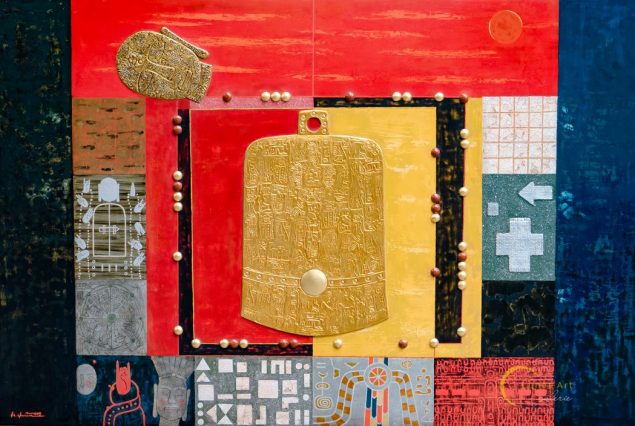“The noun Laquer is a new noun that was later used to refer to a technique formerly known as Son Ta, but completely transformed by the art of lacquer.
Son Ta technique is similar to Chinese painting, dating from the Han Dynasty. Raw paint is used with Son Ta. This raw paint, in our country, is produced a lot in Phu Tho and still sold to China and Japan.
From 1931 onwards, the use of Son Ta as well as Chinese paint in China and Japanese paint in Japan was to cover objects to made it look gorgeous, on common objects such as trays, caskets, clogs, furniture like long incense, dishes, decorations such as couplets, diaphragm, front screen … great colors to have: vermilion, black, brown, puce, gold, silver according to tradition. Strictly speaking, Son Ta was only used for decoration, the position is in decoration. Although in Japan, the art of painting is more delicate, but no countries had thought of exploring, using paint materials in a traditional, adventurous way in the art of painting to find a way to increase dignity of fine art paint by inventing further its capabilities.
However, from 1931 afterwards, thanks to the earnest search of a number of talented painters who had put off oil paints and transferred them to lacquer, Son Ta was able to go beyond the restraining place, proudly on the vast road of painting, advanced to the unfamiliar sky, from the casket, the clog, it transcended the precious framed painting, from a dependent means of decorating objects, it became an unique means of expressing the artist’s mind and soul, a means that overwhelms oil painting.
Forgetting the past, Son Ta changed its name to Laquer.
– Artist To Ngoc Van-
“From a dependent means of decorating objects, it becomes an unique means of expressing the artist’s mind” – Under the outlook of art, Lacquer is considered one of the legitimate materials of art.
It is not only the creative development of Vietnamese painters, not only the exploration and development of Vietnamese traditional craft paint industry into the virtuosity lacquer painting technique in art that Son Ta has now become a pure Vietnamese term close to the art of Vietnam.
Lacquer is not only expressed from the viewpoint of conventional painting techniques such as: Composition and colors, skills and emotions, creativity and standards; but on the material of Son Ta, with the skilful and refined skill in the process of composing, each work of art is formed by the creativity of the artist, by the sublimated emotions of art.
The lacquer painting works have touched the heart of the art loving community. Moreover, lacquer material easily enters the mind and feelings of ordinary people, because it is close to the life of the Vietnamese and the Orient, it is the material from agriculture and forestry civilization. Therefore, it brings culture and art to the community in a close and easy way.
One of the wonderful things that not any painting material can be compared to Lacquer, is the maintenance of emotions for a long time. Each work may not be completed in a short time, but to complete a work of art by lacquer materials requires a very long time, going through a lot of stages. The challenge for the artist is to be creative in using materials while maintaining emotions until the work is completed. Then the new lacquer work is really a work of art.

In every lacquer painting, the artist use many materials, not only paints but also metal materials such as gold, silver, pearl shells, snail shells, eggshell, even coins or pearls … – materials that seem to be impossible to put into painting, but by the talented creativity of Vietnamese painters, those hard materials are skillfully put into the works in a harmonious way, creating artistic value and giving viewers deep emotions. And many traditional lacquer works have won noble awards at international Fine Arts contests:

Artwork “Returning” _ 1st Prize in Asean Fine Art Exhibition in 1998_Artist Nguyen Huy Hoang

Artwork “Giai Phong Road(Get off) _ Second prize of Asean Fine Art Exhibition_2001: Artist Nguyen Quoc Huy
Talented artists loyal to traditional techniques have been recognized by the world many times. The creative exploration of the artists combined with the skillful skill in using the materials that the Vietnamese artist has composed so many works that are truly outstanding, of unique value, are increasingly acknowledged by international art lovers.
Fine art museums in the world, international collectors are increasingly interested, looking for Lacquer paintings. This proves that the traditional lacquer art shown through the beautiful works of painting with high humanistic values- has confirmed Son Ta’s position to create a Vietnamese identity in the international arena.
A generation of “Son Ta Voc Viet” is in need of a development corridor and firstly needs to be welcomed by the Vietnamese people.
Luneta Phan


